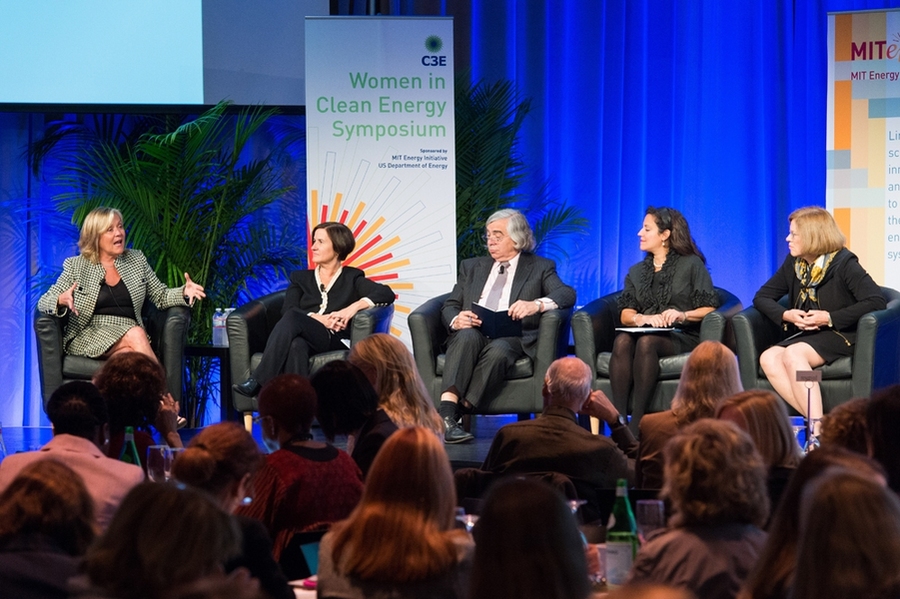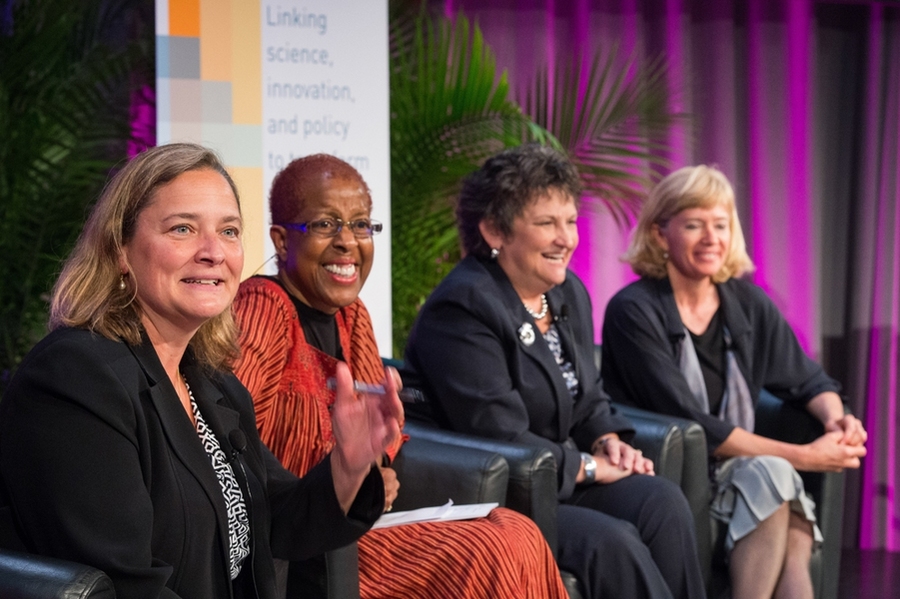Female leaders are playing a growing role in advancing the development of clean-energy technologies, helping to advance plans for carbon reduction, reduce pollution and greenhouse gas emissions, and foster job creation. Some of these women were honored in a daylong symposium at MIT on Friday, Sept. 28, the inaugural event of an initiative, created in 2010 by the U.S. Department of Energy with eight partner governments, called Clean Energy Education and Empowerment, or C3E. The MIT Energy Initiative partnered with C3E to produce the symposium as well as an awards program.
MIT president emerita Susan Hockfield opened the symposium, recalling the launching of MIT’s Energy Initiative as one of her very first acts upon assuming the Institute’s presidency eight years ago. “The most important challenge for this generation,” she said, “is building a sustainable energy system for the future.”
That requires a multipronged approach, she said: “Great technology will never win alone; it needs to be paired with policy.” The key, Hockfield said, is “turning ideas into action.” When she gives talks on energy, she said, her audiences are largely male. But, she added, “Women are awfully good at turning ideas into action.”
Many of the women who were featured as speakers or who received awards at the symposium have embodied those concepts as leaders of companies, as government officials, or as researchers or educators.
One of those leaders is South Africa’s minister of energy, Elizabeth Dipuo Peters, who gave a keynote address. “The development of the clean-energy sector will revolutionize the energy sector,” she said.
In Africa, while the availability of grid-provided electricity varies greatly, overall “the proportion without access is higher than on any other continent,” Peters said. That lack of electricity, she said, “has simply crippled industrialization in Africa.” Globally, she said, about 1.5 billion people lack access to reliable electricity, which she called “a fundamental need.”
Some 85 percent of South Africans have regular access to electricity, leading the continent’s 54 nations, Peters said, adding, “People follow where the bright lights are shining.” But decentralized power systems could leapfrog traditional grids — much as the explosive growth of cellphones in the developing world has bypassed traditional telephone networks.
Nontraditional energy sources could also have a major impact in Africa, Peters said. “The ocean currents along 2,000 kilometers of coastline could meet all of our energy needs,” she said. Or, through a widespread deployment of solar power, she said, “South Africa could meet all of Africa’s energy needs.”
Africa is “poised for change,” Peters concluded. “The 21st century is indeed Africa’s century, with a bright future.”
Other speakers at the symposium echoed that call for innovative energy solutions in developing nations. Richenda Van Leeuwen, director for energy and climate at the Energy Access Initiative Team of the UN Foundation, said that “some developing countries are ahead of where we are here at home” in their efforts to develop decentralized energy systems.
Allison Archembault, president of Earthspark International, described her organization’s work to bring electricity to Haitians, only 25 percent of whom now have regular access. To remedy that, EarthSpark provides decentralized battery-charging facilities and rents out charged batteries for use in lighting, cellphone charging and other needs. Some of these customers, in turn, rent out charging capacity to their neighbors for a small fee. By displacing the kerosene most Haitians use for lighting, the organization not only cuts the cost of energy, but also eliminates a major source of indoor pollution.
Rhonda Jordan, a doctoral student in MIT’s Engineering Systems Division, described a startup called Egg Energy that has been deploying decentralized systems in Tanzania, where only 14 percent of people have access to electricity. There, she said, the issue is a “last-mile” problem: The country has a widespread electric grid, but alongside a highly inefficient distribution system and prohibitive costs. Egg Energy been targeting Tanzania’s rural homes and small businesses, providing access to power produced either by the grid or by off-grid solar power systems, which are used to charge batteries that can each provide about two days of electricity for household use.
The symposium’s speakers ranged from those working on small-scale individualized energy solutions to those working at the highest levels of government or corporations. But, these leaders pointed out, with many national and international energy plans stalled, local initiatives often are leading the way. Among other things, energy efficiency has been embraced by some states and cities, forging ahead of national standards.
Henrietta Davis, the mayor of Cambridge, said that “action on things like energy efficiency is very much on the local level,” pointing out that, besides Cambridge, cities including Boston, New York, Los Angeles and Washington have instituted efficiency programs of their own.
“The time is finally right for energy efficiency to be considered as a national strategy in itself,” said Kateri Callahan, president of the Alliance to Save Energy, which works with government officials and corporate and NGO executives to establish strategic energy plans.
One highlight of the symposium was the presentation of a Lifetime Achievement Award to Mildred Dresselhaus, Institute Professor Emerita of Physics and Computer Science and Engineering. She received tributes from two former students, one of whom called her a “bhodisatva, a bringer of enlightenment,” and another who said, “Millie changed my life,” and has “remained my mentor, ever after I left here years ago.”
MIT President L. Rafael Reif presented the award to Dresselhaus, citing her significant accomplishments in developing thermoelectric devices. “Everyone who spends a few minutes with her,” he said, “knows the brilliance of her mind.”
Six other awards were also presented, along with a student poster award selected by symposium participants.
MIT president emerita Susan Hockfield opened the symposium, recalling the launching of MIT’s Energy Initiative as one of her very first acts upon assuming the Institute’s presidency eight years ago. “The most important challenge for this generation,” she said, “is building a sustainable energy system for the future.”
That requires a multipronged approach, she said: “Great technology will never win alone; it needs to be paired with policy.” The key, Hockfield said, is “turning ideas into action.” When she gives talks on energy, she said, her audiences are largely male. But, she added, “Women are awfully good at turning ideas into action.”
Many of the women who were featured as speakers or who received awards at the symposium have embodied those concepts as leaders of companies, as government officials, or as researchers or educators.
One of those leaders is South Africa’s minister of energy, Elizabeth Dipuo Peters, who gave a keynote address. “The development of the clean-energy sector will revolutionize the energy sector,” she said.
In Africa, while the availability of grid-provided electricity varies greatly, overall “the proportion without access is higher than on any other continent,” Peters said. That lack of electricity, she said, “has simply crippled industrialization in Africa.” Globally, she said, about 1.5 billion people lack access to reliable electricity, which she called “a fundamental need.”
Some 85 percent of South Africans have regular access to electricity, leading the continent’s 54 nations, Peters said, adding, “People follow where the bright lights are shining.” But decentralized power systems could leapfrog traditional grids — much as the explosive growth of cellphones in the developing world has bypassed traditional telephone networks.
Nontraditional energy sources could also have a major impact in Africa, Peters said. “The ocean currents along 2,000 kilometers of coastline could meet all of our energy needs,” she said. Or, through a widespread deployment of solar power, she said, “South Africa could meet all of Africa’s energy needs.”
Africa is “poised for change,” Peters concluded. “The 21st century is indeed Africa’s century, with a bright future.”
Other speakers at the symposium echoed that call for innovative energy solutions in developing nations. Richenda Van Leeuwen, director for energy and climate at the Energy Access Initiative Team of the UN Foundation, said that “some developing countries are ahead of where we are here at home” in their efforts to develop decentralized energy systems.
Allison Archembault, president of Earthspark International, described her organization’s work to bring electricity to Haitians, only 25 percent of whom now have regular access. To remedy that, EarthSpark provides decentralized battery-charging facilities and rents out charged batteries for use in lighting, cellphone charging and other needs. Some of these customers, in turn, rent out charging capacity to their neighbors for a small fee. By displacing the kerosene most Haitians use for lighting, the organization not only cuts the cost of energy, but also eliminates a major source of indoor pollution.
Rhonda Jordan, a doctoral student in MIT’s Engineering Systems Division, described a startup called Egg Energy that has been deploying decentralized systems in Tanzania, where only 14 percent of people have access to electricity. There, she said, the issue is a “last-mile” problem: The country has a widespread electric grid, but alongside a highly inefficient distribution system and prohibitive costs. Egg Energy been targeting Tanzania’s rural homes and small businesses, providing access to power produced either by the grid or by off-grid solar power systems, which are used to charge batteries that can each provide about two days of electricity for household use.
The symposium’s speakers ranged from those working on small-scale individualized energy solutions to those working at the highest levels of government or corporations. But, these leaders pointed out, with many national and international energy plans stalled, local initiatives often are leading the way. Among other things, energy efficiency has been embraced by some states and cities, forging ahead of national standards.
Henrietta Davis, the mayor of Cambridge, said that “action on things like energy efficiency is very much on the local level,” pointing out that, besides Cambridge, cities including Boston, New York, Los Angeles and Washington have instituted efficiency programs of their own.
“The time is finally right for energy efficiency to be considered as a national strategy in itself,” said Kateri Callahan, president of the Alliance to Save Energy, which works with government officials and corporate and NGO executives to establish strategic energy plans.
One highlight of the symposium was the presentation of a Lifetime Achievement Award to Mildred Dresselhaus, Institute Professor Emerita of Physics and Computer Science and Engineering. She received tributes from two former students, one of whom called her a “bhodisatva, a bringer of enlightenment,” and another who said, “Millie changed my life,” and has “remained my mentor, ever after I left here years ago.”
MIT President L. Rafael Reif presented the award to Dresselhaus, citing her significant accomplishments in developing thermoelectric devices. “Everyone who spends a few minutes with her,” he said, “knows the brilliance of her mind.”
Six other awards were also presented, along with a student poster award selected by symposium participants.







